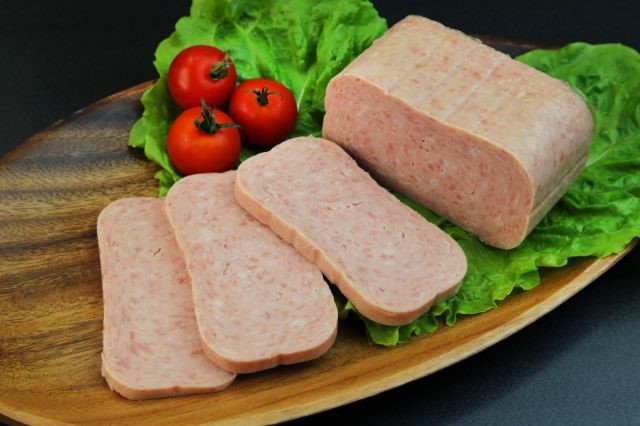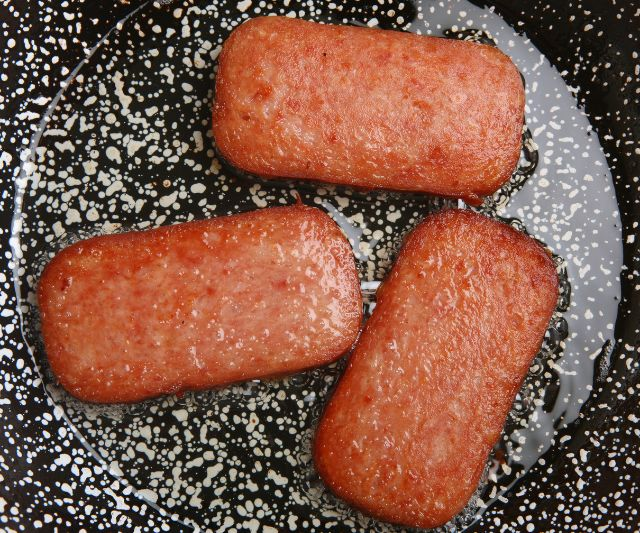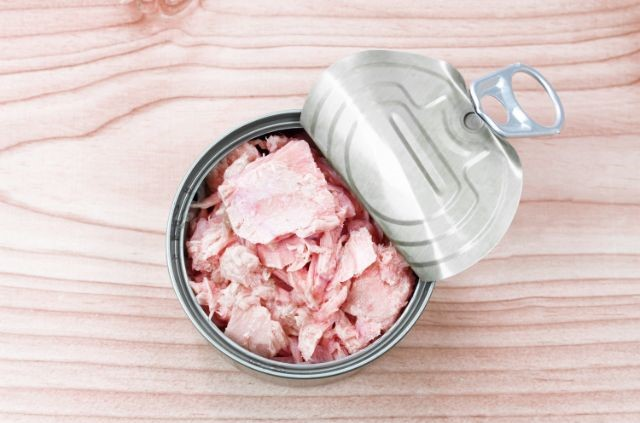Is Spam Good For Weight Loss?
This post may contain affiliate links which means I may receive a commission for purchases made through links at no extra cost to you. See my disclosure policy for more information.

No, Spam is not typically considered weight loss friendly because of its high sodium content, saturated fat, and classification as processed meat all of which pose potential health risks and are not something you want to be having every day.
This canned meat product was popularized during World War II by Hormel Foods due to its long shelf life and portability, however, it has drawbacks when it comes to a weight loss journey.
While it offers some protein, the trade-offs make it less suitable as a frequent addition to a weight-loss diet. This, however, doesn’t mean that Spam can’t be enjoyed occasionally within a balanced and nutritious diet.
You can find it in traditional dishes like spam musubi and spam fried rice, and some even eat spam raw.
Let’s delve into the details of eating spam and its effects on your health and diet.
Nutritional Value of Spam
As per the USDA, 2 ounces of Spam provides the following nutrients:
Serving size: 2 oz (56 g)
Calories: 176 kcal
Fat: 14.9 g
Total carbs: 2.58 g
Fiber: 0 g
Protein: 7.5 g
The Potential Benefits of Spam for Weight Loss

Despite the less-than-perfect nutritional profile, spam does have some elements that could play a role in weight loss, albeit within a broader, balanced, and controlled diet. Let’s take a closer look at these components and understand the scientific rationale behind their potential weight loss benefits.
Protein Powerhouse
Firstly, spam is rich in protein. This macronutrient is the building block of your muscles and tissues and plays a crucial role in weight loss for several reasons.
Protein-rich foods tend to be more satiating than those high in carbohydrates or fats. When you consume protein, it slows down digestion, making you feel fuller for longer.
This increased feeling of fullness could lead to reduced calorie intake over the day, which is helpful when you’re trying to lose weight.
Furthermore, protein has a higher thermic effect than other macronutrients, which means your body uses more energy (calories) to digest protein compared to fats and carbs.
This boosted metabolic rate can contribute to increased calorie burning, further supporting weight loss efforts.
Calorie Control
Although spam isn’t the leanest protein source, its caloric content is reasonable. So you don’t have to worry about the calories in one slice or spam. As long as you’re able to balance your diet and your calorie needs, including spam occasionally won’t derail your weight loss journey.
Remember, losing weight is fundamentally about creating a calorie deficit, where you burn more calories than you consume. In this context, spam can fit into a calorie-controlled diet.
However, it’s crucial to underline that not all calories are equal when it comes to weight loss and overall health.
A calorie from a highly processed food source like spam doesn’t offer the same nutritional value as a calorie from whole, unprocessed foods.
Quality matters as much as quantity in a well-balanced diet.
Convenience Factor
Spam’s convenience as a quick and easy source of protein can’t be understated.
For those who struggle with meal prep or find themselves frequently short on time, spam can provide a fast, protein-rich option.
But this convenience factor should be balanced with an understanding of the health implications of frequently eating spam or any processed meat.
Also Read: Are Aussie Bites Good for Weight Loss?
Downsides of Consuming Spam for Weight Loss

While we’ve discussed some potential benefits of consuming spam, it’s critical to also examine the other side of the coin. From its high sodium content to its status as a processed meat product, the downsides of eating spam for weight loss are important considerations.
The Sodium Issue
One of the main health concerns about spam is its high sodium content. A single serving of spam can contain over half of the recommended daily sodium intake.
When we talk about sodium, we often think of its immediate effects on blood pressure. Sodium promotes fluid retention in the body, leading to increased pressure on the blood vessels.
Over time, this high blood pressure can lead to hypertension, a risk factor for heart disease and stroke.
Furthermore, excess sodium in your diet could disrupt your weight loss efforts.
Retaining more fluid due to a high-sodium diet can lead to weight gain or at least make weight loss harder.
Processed Meats and Health Risks
Another downside to consuming spam for weight loss lies in its classification as a processed meat product.
According to the World Health Organization, consuming processed meats can lead to an increased risk of certain types of cancer, specifically colorectal cancer.
Processed meats, including spam, hot dogs, and some types of sausage, undergo methods such as salting, curing, or smoking, which could lead to the formation of potentially cancer-causing (carcinogenic) substances.
The consumption of these processed meats then introduces these substances into the body, which may increase cancer risk.
Nutrient Composition
When you consume spam, you’re also getting a significant amount of unhealthy saturated fats along with protein.
Saturated fats are known to raise the level of cholesterol in your blood, which can increase your risk of heart disease.
While spam does have protein – a macronutrient beneficial for weight loss – the trade-off might not be worth it when you consider the other components of this processed meat product.
Food Quality and Diet Displacement
Lastly, regularly including spam in your diet could displace healthier food choices.
For instance, if you opt for spam instead of lean protein sources like chicken breast or fish, you’re missing out on better quality nutrition.
Moreover, a diet high in processed foods like spam is often less satisfying compared to a diet rich in whole foods, leading to increased calorie intake and weight gain over time.
Incorporating spam into a Balanced and Healthy Weight Loss Diet
If you’re a fan of spam and find it hard to completely let go. Here are some ways to incorporate it into your diet while keeping your health and weight loss goals in check.
Moderation, Moderation, Moderation
Like many indulgent foods, the first rule of thumb with spam is moderation. Occasional processed meat consumption, such as eating spam once in a while, is unlikely to derail your diet or lead to health issues.
The trouble arises when processed foods like spam become dietary staples instead of occasional treats.
Even within a calorie-controlled diet, frequent spam consumption could still have negative impacts due to its high sodium and saturated fat content.
The American Heart Association recommends no more than 2,300 milligrams of sodium per day, with an ideal limit of 1,500 milligrams for most adults, and a single serving of spam comes in at around half of this.
Smarter Serving Sizes and Variations
When you do choose to eat spam, be mindful of portion sizes.
A smaller serving of spam, perhaps with some vegetables and potato starch for added fiber, can help keep your calorie and sodium intake in check.
Also, consider the other ingredients you’re using with it.
For instance, pairing spam with a heap of veggies in a stir-fry can help balance out the meal and provide essential nutrients.
Spam Lite, a variant of the traditional product, is another option. This version contains fewer calories and less fat and sodium than regular spam, making it a better choice for those watching their diet.
However, even with these reductions, it’s still crucial to consume it in moderation due to its status as a processed meat product.
Balanced Eating
Whenever you consume processed foods like spam and salami, aim to balance it out with nutrient-dense, whole foods.
This might mean having spam alongside a hearty serving of mixed vegetables or opting for brown rice instead of white rice with your spam fried rice.
When creating a meal plan that includes spam, also consider the other foods you’re consuming throughout the day.
Aim for a balance of proteins, carbohydrates, and healthy fats, and try to limit other high-sodium foods in your meals.
Education and Awareness
Lastly, I want to add that you have to be informed about what you’re eating. Understand the nutritional content of spam and other processed meats.
Being aware of the potential health implications can help guide your choices and ensure you’re not over-relying on these types of foods.
Also Read: Are Pork Chops Good for Weight Loss?
Alternatives to spam for Weight Loss
While spam has its unique taste and convenient qualities, maintaining a healthy diet requires considering healthier alternatives that can satisfy your protein needs.
Here, we explore a few of these options and the science behind why they make excellent substitutes.
Lean Meats

Lean meats like chicken, turkey, and fish are fantastic alternatives to spam. They’re high in protein, like spam, but contain less saturated fat and sodium, making them a healthier choice overall.
The protein in these meats helps increase satiety, reducing your overall calorie intake.
Plus, lean meats are a rich source of essential nutrients like B vitamins, iron, and zinc, which are necessary for various bodily functions, from energy production to immune support.
Although they are low in vitamin C, you can complement that by adding green leafy vegetables.
Plant-Based Proteins

If you’re willing to explore outside the animal kingdom, plant-based proteins like lentils, chickpeas, and tofu offer a nutrient-packed alternative.
These foods are high in protein and fiber – a powerful combination for weight loss.
Dietary fiber slows digestion, helping you feel full for longer, and reducing snacking and overeating.
Additionally, high-fiber diets have been associated with lower body weight, smaller waist circumference, and a decreased risk of obesity.
Plant-based proteins also deliver other essential nutrients such as iron, magnesium, and essential amino acids, supporting your overall health while aiding weight loss.
Canned Alternatives

If you appreciate the convenience of canned meats, options like canned tuna, salmon, or even canned chicken are typically lower in sodium and saturated fats than spam.
They provide a quick, convenient source of protein, omega-3 fatty acids, and other vital nutrients.
However, it’s essential to be mindful of the salt content in these products as well. Opt for versions in water rather than brine, and check for any added sodium or sugars on the label.
Eggs

Eggs are another superb alternative. They’re low in calories, high in protein, and packed with vital nutrients.
Eggs also have the added advantage of being very versatile – boiled, scrambled, poached, or worked into a vegetable omelet, they can make for a nutritious, satisfying meal.
Studies have shown that eating eggs for breakfast, compared to a bagel-based breakfast with the same calorie content, could help you eat less throughout the day, promoting weight loss.
Also Read: Is Pepperoni Good for Weight Loss?
Conclusion
In closing, I’d like to reflect on the notion of choice and personal responsibility when it comes to our diets.
We’ve talked a lot about spam, its nutritional value, and how it fits into a weight loss strategy. But beyond the specifics of any one food, I believe it’s crucial to remember that we each have the power to shape our diet and health outcomes.
Every time we sit down to eat, we make a decision about what kind of fuel we’re giving our bodies.
And though it might not seem like it at the moment, these small decisions accumulate over time, profoundly impacting our health, well-being, and weight.
So, whether it’s spam or any other food, let’s choose wisely and give our bodies the respect and nourishment they deserve. After all, as the old saying goes, “We are what we eat.”
FAQ
Which Spam is the healthiest?
The healthiest Spam variant is likely “Spam Lite,” which has less sodium and fewer calories and fat compared to regular Spam.
Is Spam a bad or unhealthy food?
While Spam isn’t inherently bad, its high sodium and saturated fat content coupled with it being processed meat make it a less healthy choice, especially if consumed frequently.
Is Spam healthier than deli meat?
Comparing Spam and deli meat is a bit complex, as the nutritional value of deli meat can vary greatly depending on the type. However, both are processed meats and can contain high amounts of sodium, so it’s best to consume them in moderation.
Is Spam fattening?
Spam can contribute to weight gain if eaten in excess due to its calorie content. Like all foods, it should be consumed as part of a balanced diet.
This post may contain affiliate links which means I may receive a commission for purchases made through links at no extra cost to you. See my disclosure policy for more information.
Rahul is a professional nutritionist certified by the International Sports Sciences Association (ISSA) and a personal trainer certified through the American Council of Exercise (ACE). He has a special interest in the science of nutrition and how it can impact the body.
